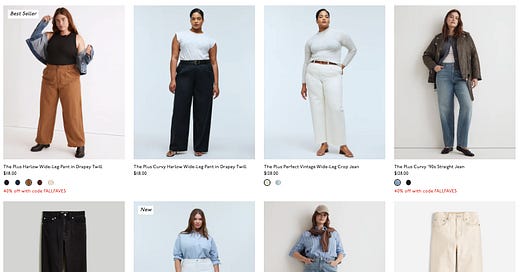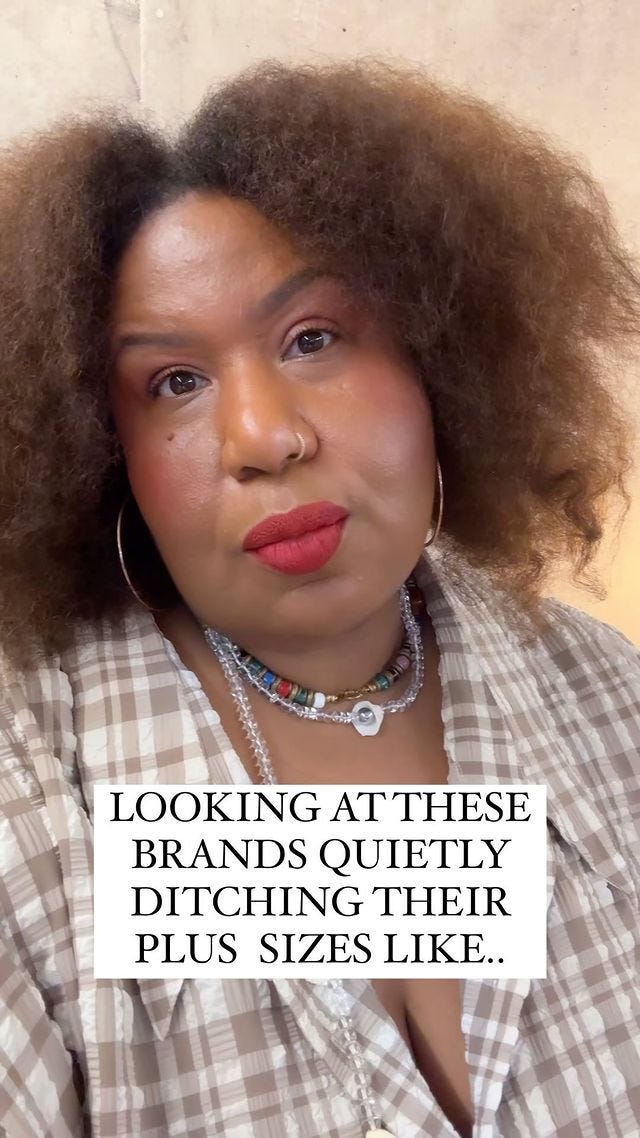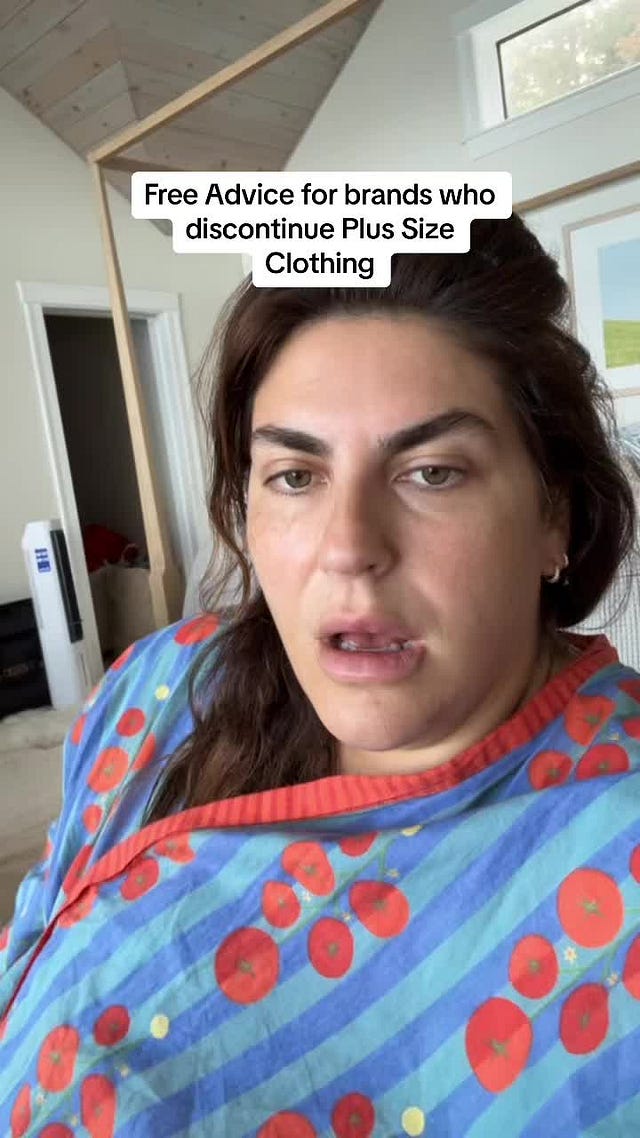Earlier this summer, I went to a discount store in Maine upon the recommendation of a friend who said they had tons of plus size Madewell. When I got there, it was true. There was a whole rack dedicated to size 26W and 28W Madewell jeans. I tried on a pair that was $29.99 and I liked them enough to snap a dressing room photo. In the end, I didn’t buy them because I was in a hurry and didn’t want to regret the purchase.
Not buying the jeans is a decision I have come to mildly regret because Madewell’s biggest sizes seem to be quietly disappearing from their website. As of today, there are only eight styles of size 28W pants, the biggest pant size they offer. One is sold out and four of those are low in stock. Compare that to the 97 styles of jeans available for a waist size 30.
This post is not paywalled, but I rely on the support of paid subscribers in order to write things like this and keep them free! Please consider becoming a paid subscriber.
Last week in the SellTradePlus open thread, someone mentioned they had gotten an email from Madewell about plus size offerings. Here is the email:
As part of our ongoing efforts to perfect our fit across the collection, we’ve made the decision to focus our size range starting with the new Fall assortment. We’ll continue to offer denim up to size 24W online, and other apparel up to 20W and 3X. Truly appreciate you taking the time to share your concerns here, and want to let you know that we’re passing your feedback on to the appropriate teams.
If you are a plus size person shopping at Madewell, this probably will not surprise you. Brands never straightforwardly announce that they are going to stop serving you. You just begin to notice that your size is never in stock any more. Then your size isn’t even listed and you wonder if you just imagined that you used to be able to shop there at all. Are you crazy? You are not crazy, it’s like retail gaslighting. You’ve been phased out without a word.
Obviously Madewell isn’t the first or only brand to do this. A few summers ago I bought multiple pairs of size 26 shorts from H&M and now when I filter for size 26 there is but one lonely pair of slacks. American Eagle, who used to make up to size 24 in jeans, now has only one style of denim in stock in a size 22. Everyone remembers Old Navy briefly bringing plus sizes into stores before yanking them back out. More recently, we’ve been mourning the losses of some size inclusive slow fashion brands like Sotela and Mara Hoffman.
A story from Vogue Business confirms what we have all been noticing:
[…] retailers that have traditionally catered to the plus-size market have reduced their options. Retailer Reformation’s extended sizing line has shrunk by 46 per cent year-on-year. Asos’s curve line, meanwhile, has gone from making up to 3 per cent of the site’s total arrivals in 2023 to 1.7 per cent this year.
But the fact that Vogue’s research backs up my suspicions isn’t exactly reassuring. Knowing that clothing options in my size are dwindling, I can’t help but overanalyze that email from Madewell—which, to be fair, is just a response from a customer service representative. It’s not a press release or a public statement. But when I read into it, what I hear is, “We have decided to stop trying to perfect our fit for you.”
Earlier this week, in an article about the effects of weight loss drugs on shopping habits, The Washington Post reported that “according to research from Impact Analytics, which helps retailers manage their inventory and sizing […] sales of L, XL and XXL have decreased by nearly 11 percent.” These statistics leave me with a lot of questions: Is Ozempic really the only possible reason sales in those sizes are down? Are retailers stocking fewer sizes because they know customers are getting thinner or are customers buying fewer large sizes because we can’t find them in stores? Could they be advertising their bigger sizes less? Are clothing manufacturers be making fewer of those sizes? No one knows or seems to be asking, but the articles goes on to say that, “the downsizing trend could also erode a decade of size inclusivity progress in retail.”
These statistics help put Madewell’s decision into context. Discontinuing their largest sizes is a financial decision; an attempt to keep up with the trends they think they can see coming. But as a person who appreciated having Madewell as an option available to me, it’s hard not to feel emotional about the loss.
Because, yes, unless you’ve been living under a rock, you know that weight loss drugs are a thing right now. We also know that only “32% of patients were still taking a GLP-1 medicine for weight loss after 12 months” and that people who discontinue use of GLP-1 agonists regain most of the weight they lost. So even if companies are expecting sales of larger sizes to be down, it would be short-sighted to view that as a permanent shift. But brands know that they can cut plus sizes and plus size consumers will come right back if and when the bigger sizes return. Because what other option do we have?
As a story from July 2024 in Vogue Business says:
Analysts agree that the pop culture influence of weight loss drugs is giving luxury labels and mass-market brands, alike, licence to refocus on straight-size. “Luxury brands have long been staunchly unwilling to cater to plus-sizes outside of the occasional token representation, but typically premium and mass players would invest more readily in plus-size,” says Marci. “Now we’re seeing the effects of Ozempic and weight loss culture on retail as a whole.”
As retailers like Madewell align with our culture’s current obsession with weight loss, it can be hard not to feel like doors are always closing and never opening. When I asked followers of SellTradePlus if anyone had heard of any brands expanding sizes, I got very few responses. But there are a few brands that have expanded their size ranges recently: Saint Somebody to a size 24, Quince to a 3x. Tamara Malas (size 0-36) is opening a brick and mortar. I’ve also noticed more brands like Lora Gene and Connally Goods offering made to measure options for people outside of their standard size ranges. And I just heard about Laws of Motion, a new brand that claims to offer 1,260 precision sizes between 00 and 40 that are assigned to you using AI, based on a fit quiz or body scan—so maybe technology will finally work in our favor?
 Tiktok failed to load.
Tiktok failed to load.Enable 3rd party cookies or use another browser
None of these options feel like a perfect replacement for the stylish, cool girl basics that Madewell sells. I am far from the only person, or even the person most impacted by these changes, but a brand’s decision to do away with my size stings. It hurts in practical ways, like having one less place I can actually find jeans that fit me and one less place I can place an expedited order for something because in person options in my size are few and far between.
Madewell also felt like one of few crossover places, where straight-size friends and I could consider some of the same styles—even when pieces available in my size were not available in store and were notably fewer. Something is better than nothing, right?
One thing I tell myself when I feel a sense of urgency around a sale or the sense of regret when I miss out on something like those deeply discounted Madewell Jeans, is that there will always be something new to want. And that remains true, even when brands close or discontinue sizes. As long as we live under capitalism, people will find new things to try and sell us. And hopefully some of those things will be in my size.
In the meantime, this is a good reminder of why we should opt out of the fast fashion system wherever and whenever we can. Learn to sew and mend. Buy something secondhand or trade clothes with a friend. Try to find ways to keep yourself comfortably clothed without relying only on brands who will make financial decisions that leave you in the lurch. Madewell was never going to save us.
This post may contain affiliate links









I sort of wonder whether the declines in the small fat range are because of “vanity”changes in the size definition. It just doesn’t track for me mathematically. Even with a large number of people on (expensive) GLP-1s, and the smaller percentage of THAT group who actually lose enough to change sizes, AND then fall into straight sizes — relative to the size of the country and therefore the clothing market, it’s a small number. This is just a really strange capitalism fail. Can fat phobia really be stronger than a profit motive?
"But brands know that they can cut plus sizes and plus size consumers will come right back if and when the bigger sizes return. Because what other option do we have?"
This is so true and soooo enraging to me that I am finally taking the plunge and learning to sew my own clothes. Talk about slow fashion (ha) but I won't feel as gross about the whole ordeal at least. It makes me feel like garbage jumping through hoops to pay someone to barely entertain me as a customer, and I'm just done.